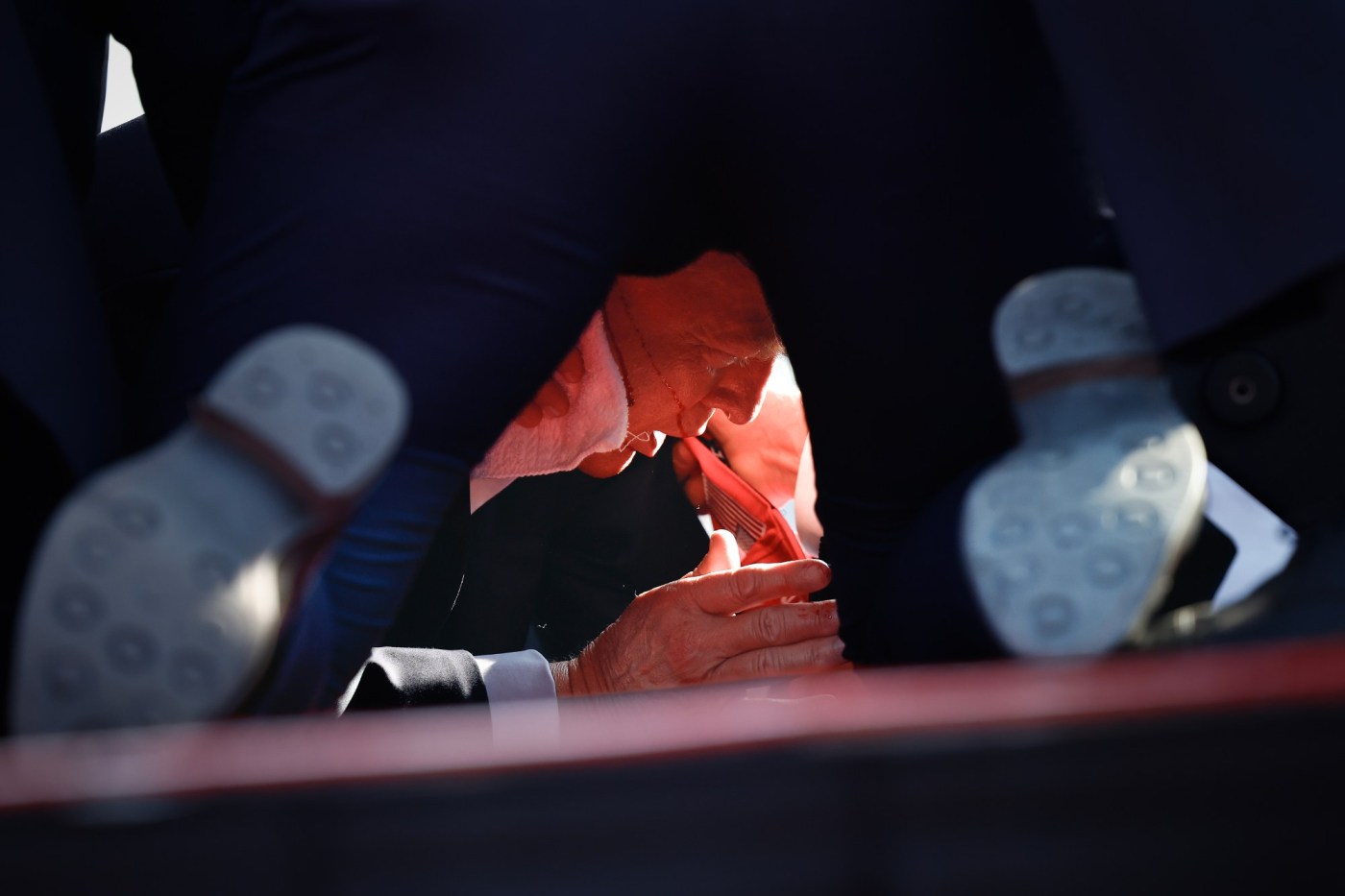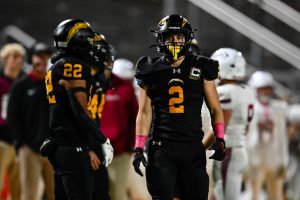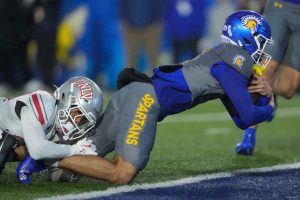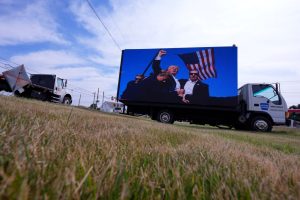And suddenly it was everywhere.
At the July 13 Trump re-election rally in Butler, Pennsylvania, shots rang out, an assassin’s bullet grazed the right ear of former U.S. President Donald Trump and photographers covering the event captured what they could of the chaotic aftermath.
Secret Service agents hustled a stunned Trump onto the outdoor stage floor, shielding him from what might follow. Then, after the “shooter down” transmission, up came the candidate, back on his feet, fist in the air, American flag behind him, clear blue sky above it all. Barely heard over the commotion, he called out “fight!” three times, giving his supporters and the cameras something to remember.
Associated Press photojournalist Evan Vucci’s image of that moment hit the news wires. Within hours, minutes, even, a confluence of political agreement emerged across right, left and center. This photo, that defiance, that flag and that fist in the air could cement the election’s outcome.
News images made under terrifying circumstances enter the world, and while the photographer may have a hunch about how they’ll be used for political or commercial purposes later, it’s too late. It’s out of the bag. But what transforms some photos into icons — we’ll use that word once, and cautiously, as with any “iconic”-adjacent word — while more complex images from the same, recent, tragic event take a back seat?
What can we find in other photographs made under extreme pressure that day, or other days in our history, Sept. 11, 2001, included, revealing different light and shadows of the same story?
I talked with Tribune senior visual editor Marianne Mather, who, like many newspaper photo editors Saturday, chose Vucci’s Trump rally photo for prominent online and print display. She has worked in Chicago as both photojournalist and photo editor. “When I saw that image,” she told me, “I knew it could change the course of the election. But that’s out of our hands.”
Our conversation has been edited for clarity and length.
Q: Why that photo above the others?
A: Action, reaction, motion and emotion — those are the four elements you want in a photo. The photos that came out of what happened at the rally have all four. They’re so impactful. But the fist pump into the air is the photo.
Republican presidential candidate former President Donald Trump gestures as he is surrounded by U.S. Secret Service agents as he leaves the stage at a campaign rally, Saturday, July 13, 2024, in Butler, Pa. (Evan Vucci/AP)
Q: Why?
A: It shows so much of what we, as Americans, prize, even with the blood dripping down Trump’s face. He’s down, but he gets up again. As a culture, we value these things. It’s an affirming image. Regardless of how it’ll be used by other people, for whatever purposes, it’s a solid, well-shot news photo.
Q: Is the photo itself inescapably political, do you think?
A: Well, yes and no. The event was inescapably political. It was a Trump rally for re-election, so we’re already in a political arena. As a photo editor, I’m always thinking: If my mother wasn’t there, what would I show her so that she understood what happened? That’s what we’re trying to do. Can images become politicized by others later? Yes. They can, and they will.
Q: Vucci’s photograph relates to another massively popular image: “Raising the Flag at Ground Zero,” taken by Thomas E. Franklin, who was a staff photographer at The Record. Resilience, framed by tragedy.
A: It speaks to what Americans love most about our country, I think. Getting back up in the fight, in the face of adversity. The firefighters, hit so hard that day, raising the flag up. It’s a moment in time, showing what America is made of.
Brooklyn firefighters George Johnson, from left, of Ladder 157, Dan McWilliams, of Ladder 157, and Billy Eisengrein, of Rescue 2, raise a flag at the World Trade Center in New York on Sept. 11, 2001. (Thomas E. Franklin/Bergen County Record)
Q: That’s how millions of people seem to be interpreting last weekend’s signature image.
A: Right. When you have a photo capturing a mood or a feeling of much of the entire country, that’s hard to deny. But we do have to remember this: It’s just one moment. There are other moments, captured before and after that one. Anna Monkeymaker’s photo (for Getty) is just remarkable, showing former President Trump as photographed through the legs of a Secret Service man. They’re all over him, trying to protect him. It’s a quieter moment — a behind-the-scenes look that’s pure storytelling. But this photo will never resonate as much with people because it doesn’t show what we love to see.
Q: It’s a really complex and ambiguous image, but it still manages to humanize the person dominating it, from an alarmingly close perspective.
A: I agree. A really great photo. That private moment, what Anna shot, is a quiet image. Evan’s is louder, and people resonate more easily with louder.
Q: You could say the same about a less well-known photograph taken at Ground Zero on 9/11, Lori Grinker’s “The Firemen and the Flag.” In a 2022 episode of the PBS series “The Bigger Picture,” Fred Ritchin, dean emeritus of the International Center of Photography, says that the best-known Sept. 11 photo, Franklin’s, was “like a victory — ‘We won!’ It’s OK. We’ll be OK.” In Grinker’s photo, the perspective’s higher, gazing down on the firefighters, and you see more of the devastation. Ritchin calls it “a probing interrogation of the event. But not an uplifting image.”
A: Also, the flag’s already raised in that photo, which is truly beautiful. It’s so well-composed. What you don’t get is the action of doing something, the actual raising of the flag, the way Franklin’s photo does. All the symbolic elements of the Sept. 11 photo we remember, the men looking up, the raised faces, the action of doing something about what just happened — all that plays into a photo’s meaning, and impact.
The American flag that was raised by firefighters above the site of the attacks on the World Trade Center in New York in 2001 is displayed at the National Sept. 11 Memorial & Museum along side the iconic photos of the firefighters raising it on the day of the attacks. (Spencer Platt/Getty Images)
Q: One last question about the images of what happened last weekend. If no one image can tell the whole story, if you’re picking which ones to publish, how do you make the call?
A: It’s a struggle sometimes. When I edited the photos on July 13 I saw the image of the fist raised, and you just knew what would happen if you put it out into the world.
Evan Vucci and (photographer Doug Mills), they got the money shot, and they risked their lives to capture that moment of history. Those show part of the story, of what happened. But there are other photos. I hope people take the time to see those, too, to get a true, well-rounded picture of that day. Before and after the fist-pump.
Michael Phillips is a Tribune critic.












